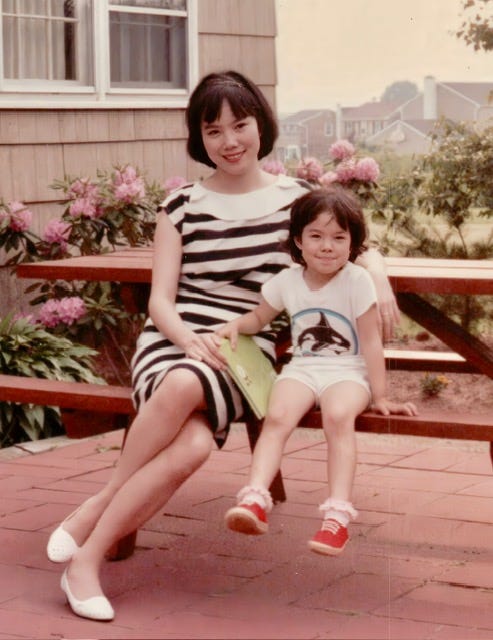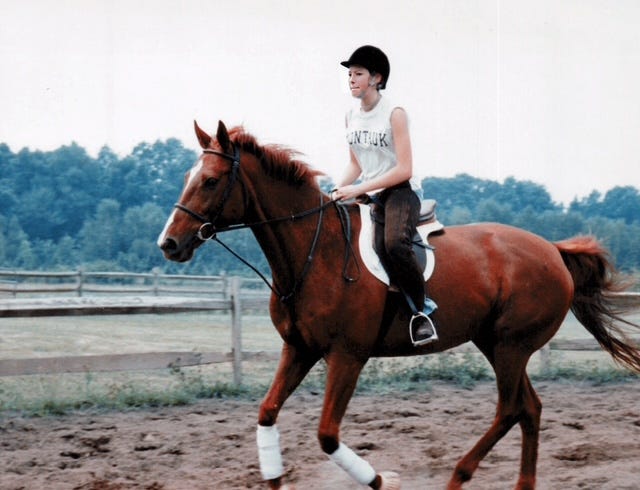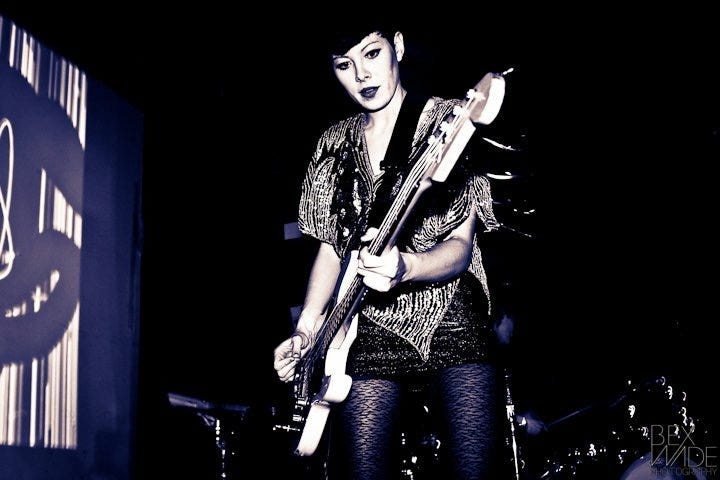Sun Shining on Morning Snow
belonging, intersectional identities, and mother-daughter relationships with Ingrid Hu Dahl
As much as the internet is responsible for the divisive hellscape we now live in, there is still something magical about how it can bring people together in positive and meaningful ways. I can’t remember exactly how Ingrid Hu Dahl popped up on my radar, but at some point we started following each other on Instagram. I immediately saw that she was a kindred spirit. Not only was she a mixed race Asian woman like myself, but more importantly, she was someone out in the world doing work that uplifts others.
Last year, as I was beginning my book tour for Not Your China Doll, Ingrid came to a screening I hosted at the Roxie Theater in San Francisco and introduced herself. We got to talking and Ingrid shared that she had been working on a memoir about growing up hapa. She mentioned that she was looking for an editor, and after a few conversations, I signed on to work with Ingrid to shape her story. (In addition to being a published author, I’m also a freelance book editor.)
I always appreciate the fact that deciding to work on a project as deeply personal as a memoir takes courage and a willingness to be vulnerable with an editor (me) they barely know! It was such an honor getting to be a part of Ingrid’s journey and to guide her book to publication. Sun Shining on Morning Snow is a memoir about being mixed race and Asian, but also so much more—it’s about Ingrid accepting and embracing her sexuality as a queer woman, learning how to live comfortably in the “spotlight,” dealing with the racism and unwanted attention that otherizes her, and navigating her relationship with her mother. Following the book’s publication last week, Ingrid and I caught up on some of the themes it addresses and why she felt compelled to write about her experiences as a queer, mixed race woman.
Although the mixed race population in America is growing rapidly, it’s still somewhat rare for people to read about the mixed race experience from an Asian perspective. Being mixed and Asian can sometimes feel like being a minority of a minority. Your memoir tackles the topic so beautifully. What made you want to write about your experiences and share them with others? Was it difficult at times to relive some of the scenes you include in the book?
Part of what made me want to write this memoir was wishing I had an elder who was mixed-race to share their stories and experience with me. There was no blueprint to navigate otherness, to sense-make daily xenphobic experiences. I felt it was important to lay bare my own story for those who might seek that perspective to feel less alone or want more clarity on what it’s like to grow up in otherness. Writing this book was catalyzed by losing my Ma to cancer three years ago. I felt compelled to write her story in my story, and in the process, healed a lot.
Growing up, I rarely—if ever—saw anyone who looked like me or lived at the intersection of Taiwanese and Norwegian identities, queerness, grief, and resilience. I wrote Sun Shining on Morning Snow to offer a mirror for others who have lived in between cultures, who’ve struggled to belong, and who’ve carried both beauty and sorrow across generations.
It was absolutely difficult at times to relive some of those scenes; especially the ones rooted in loss, silence, and misunderstanding. But writing gave me a way to process and reclaim those moments. I wrote through tears, through pain, and through a longing to honor my mother’s story and voice. It was important for me to capture our strained relationship centered on my sexuality and coming out, and how we found reconciliation, love, and forgiveness. Ultimately, it became a healing act—not just for myself, but I hope for readers who are also navigating layered identities and looking to connect with more empathy, depth, and step into their truth to live boldly.
In many ways, your memoir is a coming-of-age story that explores your intersectional identity as a mixed race, queer woman. It’s also a search for belonging and acceptance. And at the same time, the book is a fun romp through various hobbies and subcultures that you’ve been a part of on your journey of creative self-expression, most notably your career as a musician. Having lived through all of this now and learning some things the hard way, what advice or words of support would you want to give to a younger version of yourself?
What a beautiful and generous question. If I could sit with a younger version of myself, which I felt like I had the privilege of doing throughout every chapter of this book, I would tell her this:
You already belong, exactly as you are. Love isn’t conditional. You are worthy, enough, and loved. Your value does not come from pleasing others, overachieving or performing parts of yourself to fit cultural, societal, familial, or relational expectations.
I’d remind her that she did nothing wrong and that she would wield her power of empathy and kindness to help connect the fractured relationships across humanity, broken by discrimination and fear of difference. That she would find ways to help others heal from their own anger and pain, dissatisfaction, but that it would be in a manner that was boundaried and transformative via coaching and leadership shaping.
I’d tell her that she has great sources of strength and insight. And I’d tell her that softness is not a weakness. That it’s okay to ask for help. That the world will try to define you, to place a harsh spotlight on you, but your identity is not something you owe anyone an explanation for—it’s something you get to step into on your own terms. Truth to power takes courage. Push through the fear.
Looking back, I see that all the subcultures and creative spaces I was drawn to—punk, Riot grrrl, feminism—were ways of building, exploring, learning and unlearning, creating, and questioning. I’d say not to stay too long in the well, laying in pain and hurt. It’s not my well to begin with.
“You already belong, exactly as you are.” That is such a beautiful answer. Those are exactly the words I wish I could have heard when I was struggling with my mixed race identity as a teenager.
Your relationship with your mother is an important facet of the book, and it’s something I think a lot of women and Asian Americans will relate to. Did you feel that you were trying to work out aspects of your relationship by getting it down on paper?
As many Asian American daughters know, love isn’t always expressed directly in words. It’s found in gestures, in food, in the concept of sacrifice and dutiful acts. But as a queer, mixed-race daughter raised in the U.S., I often longed for more open emotional connection and understanding, and that gap became a quiet ache I carried for years.
Putting our relationship down on paper gave me a way to make sense of that ache. It allowed me to see my Ma not just as my mother, but as a full person—with her own history of displacement, grief, and resilience. She and I existed for so long with a river between us. And all we ever wanted was to be on the same side. Those divisions were not always what we chose, and sometimes, were what we held firmly. Writing helped me extend compassion in places where I once felt rejection and abandonment. But it also was a place to show that love and forgiveness transcends, that stepping into my truth inspired my Ma to come to my side of the river. We confronted truths, we felt and we let go. And, we got to see more of each other in that transformational phase of growth and evolution. That was such a gift before she passed away.
Ultimately, the writing became a bridge. It helped me grieve, honor, and express my love for her, my wife, and myself more clearly—not in spite of our complexities, but because of them. I hope that others who read it might also feel less alone in navigating the layered, tender terrain of mother-daughter relationships.
Were there any specific writers, books, musicians, or works of art that you turned to for inspiration while you were writing your memoir?
Katie, I absolutely loved your book! Your introduction took my breath away. And, I’m deeply inspired by Michelle Zauner’s memoir Crying in H Mart. Her story of her relationship with her mom and losing her, while picking up the pieces of culture and identity through food and loss were palpable. I wasn’t planning to write this book but when my Ma died, it felt like a magnetic pull that I had to do. And it was deeply cathartic. I’m sure it was like that for Michelle, too.
Other contemporaries who I’m inspired by are memoirs by Carrie Brownstein, Hunger Makes Me a Modern Girl, and iO Tillet Wright’s Darling Days.
Oh my gosh, that’s such a compliment! I’m grateful that you found inspiration in my book and Anna May Wong’s life.
What does the title of your book, Sun Shining on Morning Snow, mean? Can you also talk a little about how that image of a sunny winter morning recurs throughout the book?
The title Sun Shining on Morning Snow is a direct translation of my Chinese name. I have fond memories of Ma describing the image of sun shining after a storm, casting crystalized shimmers across the snow’s surface. And every snowflake is unique and different. What a metaphor for humanity and our ability to step into our light, our power, a spotlight that captures our essence.
A sunny winter morning is when I was born and the morning after Ma’s memorial. It covers the full spectrum of the stories’ timeline. That image became a throughline in the book—a way of holding the tension between grief and joy, between what is fleeting and what endures. Just like sunlight illuminating fresh snow, there are moments in life that are both tender and breathtaking, filled with loss and light at the same time.
I’ve come to see my name as an invitation to live in that in-between space, to embrace both the warmth and the cold. It speaks to my identity as someone who holds multiple truths—mixed-race, queer, bicultural—and finds beauty not in resolution, but in integration. The recurring image of sun on snow became a kind of emotional compass as I wrote, reminding me that even in the hardest seasons, there is clarity, hope, and the possibility of something quietly luminous and spectacular.
Follow Ingrid on Instagram at @ingridhudahl and @sunshiningonmorningsnow and on her website. You can purchase a copy of Sun Shining on Morning Snow and learn about her upcoming events here.








